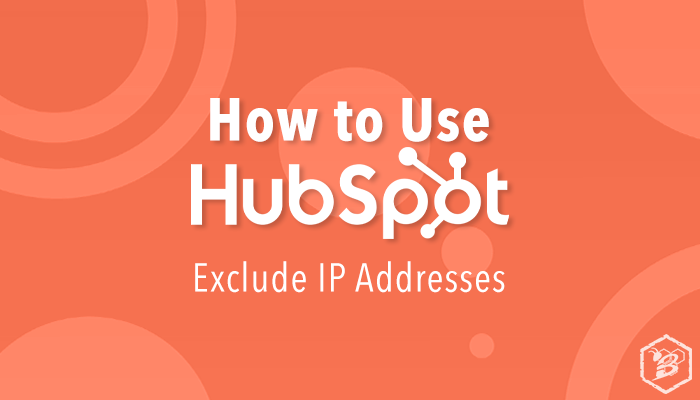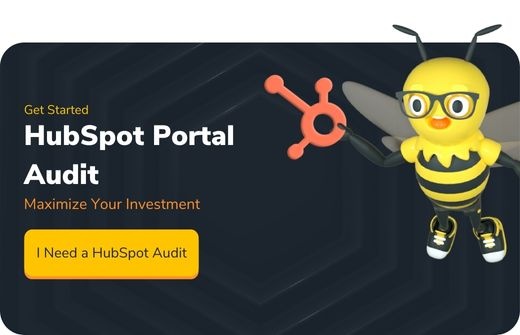Data is only useful if it's accurate. And one of the biggest mistakes that we see companies make with their reporting is that they don't exclude internal IP (internet protocol) addresses from their reporting. This means that whenever someone from your own company comes to your website, it's being counted as a new website session. Having your team utilize your website is definitely a good practice (and likely means that you have created a useful website), but we don't want to report on those people because they are not prospects. There is no chance they ever turn into a customer. Here's how you can eliminate this reporting error.
This blog post is part of our How to Use HubSpot series focused on helping our readers get the most out of their HubSpot portals with tips and tricks on best practices within HubSpot. Some features and tools can be hidden or hard to find. We're uncovering those tools. Follow along and catch all of our HubSpot tips here.
One of the biggest features of HubSpot is the seamless reporting and transparent view of your business. However, that only works if you're setting your reporting up to succeed. That means that we have to make sure that the data that we're capturing, reporting on, and optimizing for is accurate.
By excluding specific IP addresses, you can ensure that you're not reporting on internal views of the website or even views made by your contractors (agencies, freelancers, vendors, etc.). What you really want to be reporting on with your website traffic analytics is new visitors or at least visitors not associated with your company.
Here's how you can filter out specific IP addresses in order to keep your data clean:
- In your HubSpot account, click the settings icon settings in the main navigation bar (top right).
- In the left sidebar menu, navigate to Tracking & analytics > Tracking code.
- Click the Advanced Tracking tab.
- Scroll to the bottom of the page and In the IP Addresses to Exclude text box, enter IP addresses or IP ranges to exclude:
- Your current IP address appears above the text box. If you make changes to your network or have employees who visit your website from new networks, you can add additional IPs over time. If you need to find an IP address manually, try going to http://whatismyip.com or http://ip4.me. If your IP address is dynamic, find out if your internet provider can provide you with a static IP for your corporate office or home network and use that instead.
- Both IPv4 and IPv6 addresses and ranges are accepted in this field.
- An IPv4 address has the following format: x.x.x.x where x is called an octet and must be a decimal value between 0 and 255. Octets are separated by periods. An IPv4 address must contain three periods and four octets. The following examples are valid IPv4 addresses:
- 1.2.3.4
- 01.102.37.255
- An IPv6 address can have either of the following two formats: Normal - pure IPv6 format or Dual - IPv6 plus IPv4 formats. An IPv6 (Normal) address has the following format: y:y:y:y:y:y:y:y where y is called a segment and can be any hexadecimal value between 0 and FFFF. An IPv6 (Dual) address combines an IPv6 and an IPv4 address and has the following format: y:y:y:y:y:y:x.x.x.x. The following examples are valid IPv6 addresses:
- 2001:db8:3333:4444:5555:6666:7777:8888 (Normal)
- 2001:db8:3333:4444:5555:6666:1.2.3.4 (Dual)
- An IPv4 address has the following format: x.x.x.x where x is called an octet and must be a decimal value between 0 and 255. Octets are separated by periods. An IPv4 address must contain three periods and four octets. The following examples are valid IPv4 addresses:
- Use commas to separate different IP addresses (e.g., 63.139.127.5, 63.139.127.23), and dashes to represent entire ranges of IP addresses (e.g., 64.159.127.0 - 64.159.127.255).
- In the From these referrers text box, enter referrer domains or IP addresses to exclude. This is most commonly used to block unwanted or spam traffic. If you want to exclude traffic from your own external domains, learn how to track multiple domains with HubSpot.
![]()
- In the bottom left, click Save.
[HubSpot]
By doing this, you'll be on your way to better analytics and far more accurate reporting on your website, landing page, and thank you page visits.
Check back regularly to find other tips on how to use HubSpot!
Not sure if you're getting all you can out of your HubSpot portal and investment? Our HubSpot Audit will dive into every tool within the platform, evaluate usage, and make recommendations on how HubSpot can work harder for your business. Learn more about our HubSpot Audit below!




.png?width=100&height=100&name=Why%20Were%20Not%20a%20Marketing%20Agency%20(And%20What%20That%20Means%20for%20Your%20Growth).png)
